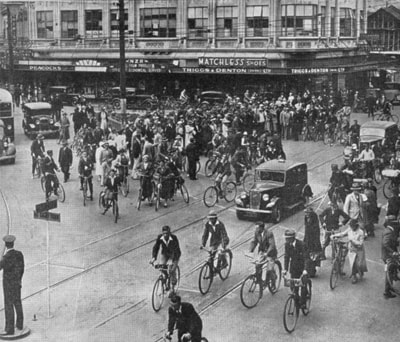There is a greatly increased awareness of disaster preparedness lately, with the devastation recently in Christchurch, New Zealand, and now Japan.
We can’t predict when an earthquake will happen here, but we know it will happen, and we all need to be as prepared as possible for that future event.
I would argue that preparing for our urban transportation future should follow a similar reasoning: preparing for the future.
We don’t know exactly when oil (and consequently gasoline) will become very scarce, and expensive — but we do know that it will happen. In fact, it is already happening (current price at the pump: $1.22/ litre, and rising), and we need to be prepared.
Most people are aware of Peak Oil, the point in time when the maximum rate of global petroleum extraction is reached, after which the rate of production enters terminal decline. We may have already passed this point of maximum production, and it is past time to start planning for the future of transportation in light of this.
So what is the future of urban transportation?
Sam Adams, mayor of Portland, Ore. — one of the most cycling friendly cities in North America — says: “Our intentions are to be as sustainable as possible. That means socially, that means environmentally, and that means economically.
"The bike is great on all three of these factors. You just can’t get a better transportation return on your investment than you get with promoting bicycling.”
This is what municipal leaders and staff from all cycling-friendly cities say: Cycling is cleaner, healthier, quieter, better for the environment and less expensive.
“With a significant increase in funding and a change of priorities, we can achieve a cycling mode share in the Valley as high as 20 per cent by 2020,” says Ed Schum of the CV Cycling Coalition.
To accomplish this we need to make cycling safer and more convenient so anyone from eight to 80 feels comfortable riding a bike. This will take a significant investment in the early stages, but overall it will be a lot less expensive, and healthier for our population, than building more roads, bridges and parking for cars.
However, says Schum: “2020 is only nine years away and some of the recent road projects show that we are still going in the wrong direction! We have to take immediate action to get the desired results: getting more people to use bicycles for transportation, by building safer and more convenient cycling infrastructure.”
In a strange coincidence, I recently encountered the image above from the past — or perhaps it is from the future, after all?
This is an intersection in Christchurch, New Zealand, in February 1937.
People of all ages are riding their bikes to work or shopping. Could it happen here?
For more thoughts on the future of transportation, visit the Comox Valley Cycling Coalition website at http://cyclecv.squarespace.com.
This article was written by Comox Valley Cycling Coalition member Krista Kaptein with contributions from CVCCo member Ed Schum.
